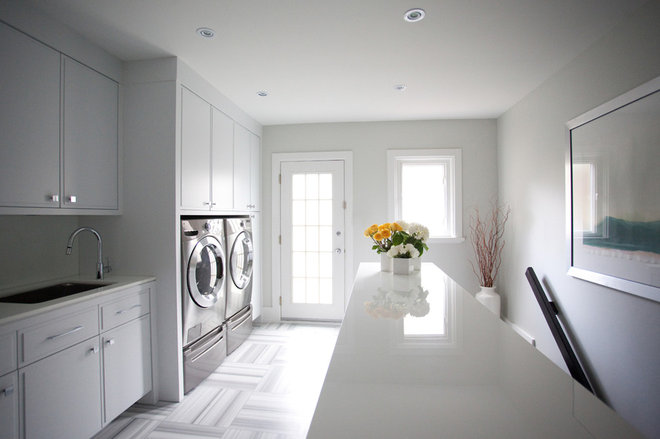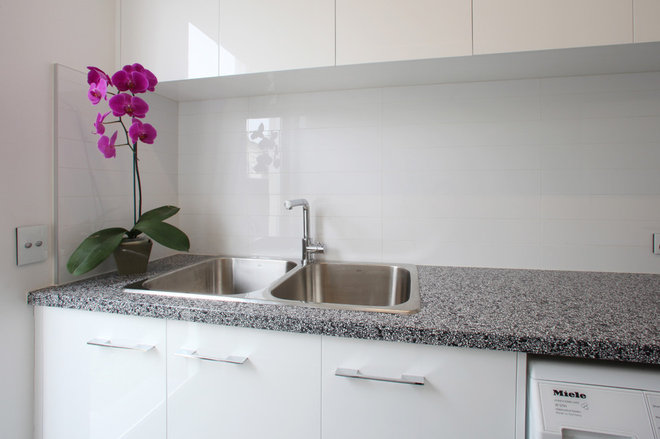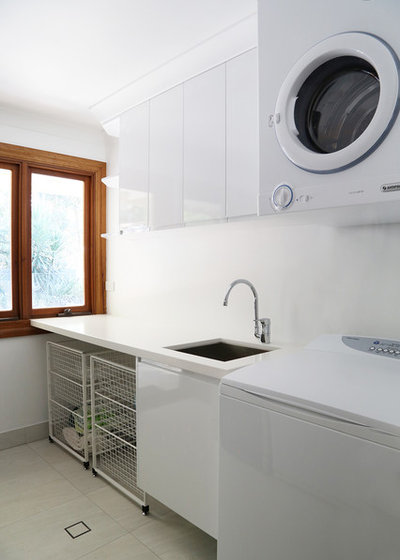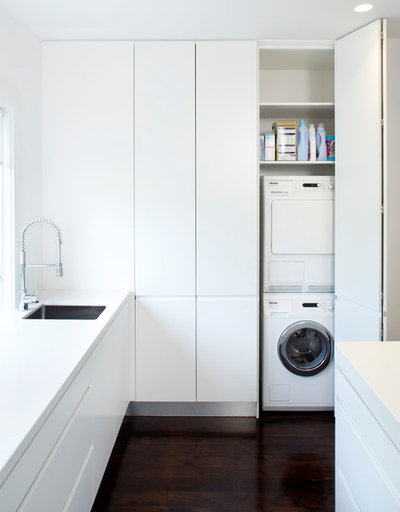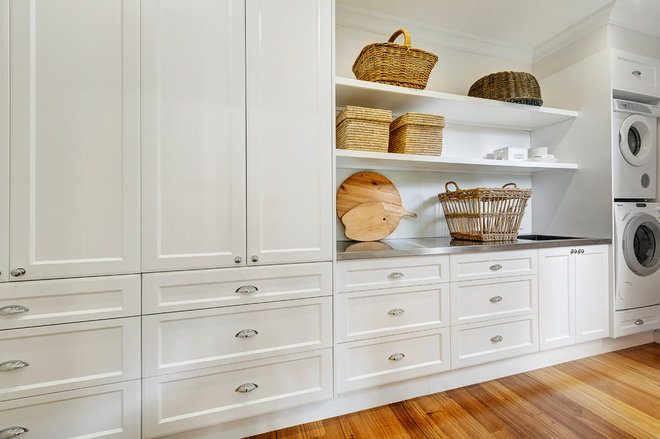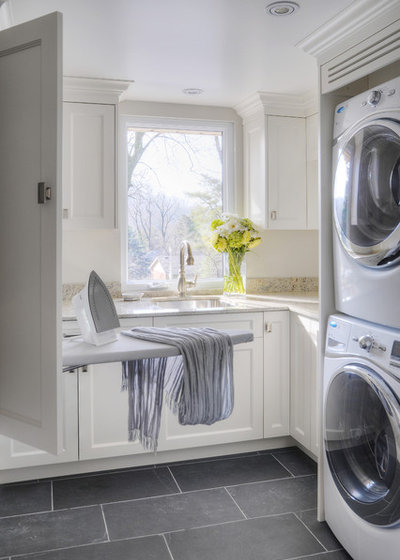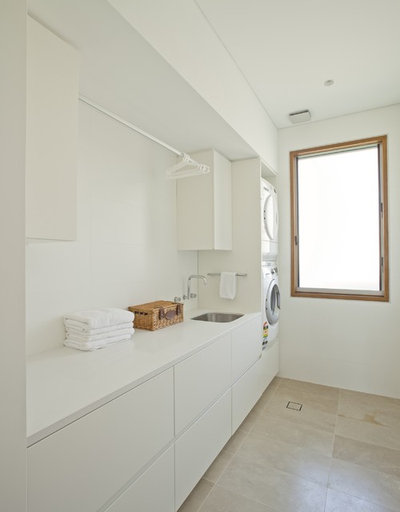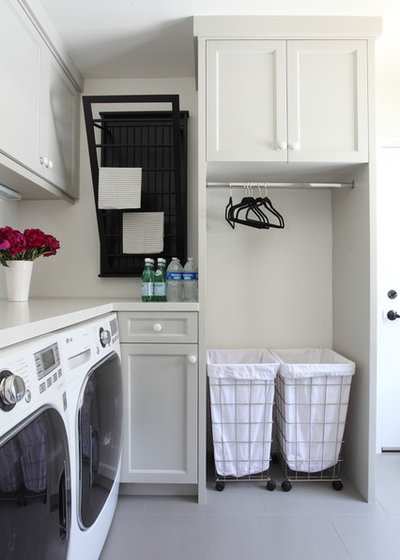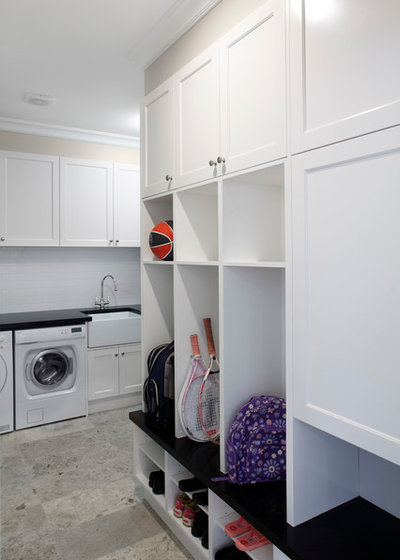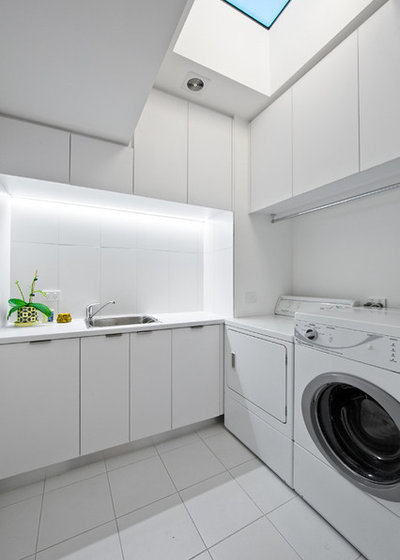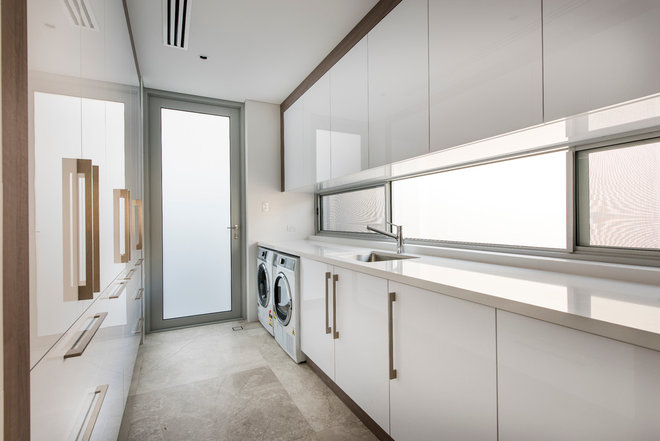10 Ideas for High-Functioning Laundries
There’s no doubt that doing the laundry is a chore, so anything you can do to create a functional, efficient and well-equipped laundry will lighten the load.
If you are renovating an existing laundry or planning to include an internal one in a new build or extension to your home, this list will help you check off the essentials in equipping your laundry with ample and clever storage, novel multipurpose ideas and great lighting and ventilation solutions.
1. Free up bench space
A cleared work surface on which to sort clothes or set down laundry baskets is indispensable to any laundry plan, even if space is limited. Keep your benchtop free of clutter by ensuring there is a designated bin for both dirty and clean clothes.Also, in the planning stage, position the benchtop to facilitate cleaning chores. Place the benchtop over stowaway laundry bins or over a front-loading washer and dryer. Clothes can be pulled from either the bins or appliances and immediately sorted on the benchtop. If your laundry is more a nook than a separate room, a slide-out work surface can also do this duty well.
Most modern benchtops are available in laminate, lacquered wood, engineered stone or even marble, and a contrast shade or material can make for a visual feature, especially if the laundry is all one colour. Choose a dark granite stone or granite laminate, similar to the benchtop pictured above, to add interest in an all-white laundry. Whatever your style or budget, make sure the benchtop material you choose is impervious to moisture. This will ensure its long life as part of one of your home’s key workstations.
2. Install deep sleek sinks
A laundry sink should be deep enough for soaking clothes and hand washing delicates, but it should also be durable and made from a tough material.
In Australia, stainless steel is popular, but it should be of a thickness and quality good enough to withstand corrosion from laundry chemicals and moisture.
A more stylish alternative is porcelain, but it’s a lot more expensive than the humble metal sink and, if not well cared for, can stain easily.
3. Stack or group washers and dryers
If laundry space is at a premium, install a stackable washing machine and dryer to leave open space for a cabinet or extra shelving.
Another space-saving idea is to opt for a pair of front-loading appliances fitted beneath a workable benchtop. This will free up the area around the sink and create a separate designated dry area for folding clean clothes and linen.
In a large laundry, conceal the washing machine and other appliances in integrated cabinetry.
4. Add plenty of functional storage
A combination of versatile storage options is key to running an efficient laundry. A mix of open shelves, cabinets and purpose-built cupboards usually keeps all your laundry products in easy reach. Extend cupboards and cabinetry as high as possible. Make sure top shelf items are those that are seldom used or should be kept out of reach of children.
Vary the size of cabinets and cupboards, too. Tall, narrow cupboards can store mops, brooms and a vacuum cleaner. Open shelving should contain items that are in regular use. Slender shelving units with an array of evenly spaced pigeonholes are ideal for keeping detergents, soaps and scrubbing brushes. Cubicles can be filled with interesting baskets or boxes packed with an array of cleaning supplies. Check out our laundry templates!
5. Store irons and ironing boards
After the laundry is clean and dry, it’s time to iron. But storing a bulky ironing board can be challenging in the confined space of a laundry.
A clever idea is to stow an ironing board in a custom-built cupboard and flip it out when needed. Keep the iron on a shelf in the same place and make sure there is an electrical socket within the cavity to conveniently power the iron.
Alternatively, mount the ironing board directly onto the wall or hang it on the back of the laundry door to keep it up and out of the way. If none of that is possible, a simple solution is to buy a small padded board designed to sit on the benchtop.
6. Place hangers and hooks up high
Once clothes are clean and crisply ironed, hang them from an airing rack or from an overhead rail set across the space between two cabinets. This will make your washing day routine run smoothly.
Wall-hung shelves, wire racks that flip up when in use, or canvas pockets slung from the back of the laundry door will also increase your laundry’s storage capacity. A bank of decorative hooks from which to hang small items, such as aprons, keys, swimming goggles or items of errant clothing, will also prove to be very handy.
7. Stow laundry baskets and bins
Whether you call them hampers or baskets, large deep bins used to hold dirty clothes need to be stored neatly out of the way in a busy laundry to avoid tripping over. They also need to be easily accessed for when loading the washing machine, so having them on wheels is ideal. Most often they are rolled under a bench, but they can also be housed in integrated cabinetry in paired chutes for dark and light clothing.
8. Create a multipurpose room
Versatile storage cabinets allow laundries to service multiple functions as a family grows and its needs change. Laundry cupboards, bins and baskets need not only store clothes and cleaning supplies, they can also be used to store sports equipment and school gear, gardening tools and boots, raincoats and umbrellas.
Open shelving is a great place to locate other items that are often used but need to be out of sight, such as sewing kits or personal project supplies. Sometimes a laundry can even function as a feeding or grooming centre for pets.
9. Flood the laundry with light
The best light in the laundry is natural light streaming in from well-placed windows. Sunlight helps you make an easy assessment of how dirty or clean something is and whether a stain you might have worked hard to remove has gone. If there is no window, consider installing a skylight for illumination. Or if the laundry is subterranean, put quality ambient lights in the ceiling and run task lighting in LED strips above benchtops to spotlight work areas. Painting walls white will also help bounce light around.
10. Follow a ventilation plan
A well-ventilated laundry has windows and a door leading directly outside to a clothesline. A glass door is ideal as it allows more natural light in the room. Keeping windows and the back door open during washing or drying cycles allow for excess moisture to be drawn outside. Similarly, fumes can easily escape externally when soaking white clothing in bleach or using other toxic chemicals in the sink. This will work even better if the sink is located near a window.
If these simple solutions are not possible, an extraction fan or vent to the outside is best. The fan will help eliminate mould caused by moisture and can expel the fumes omitted from some household cleaning products commonly used in the laundry.


